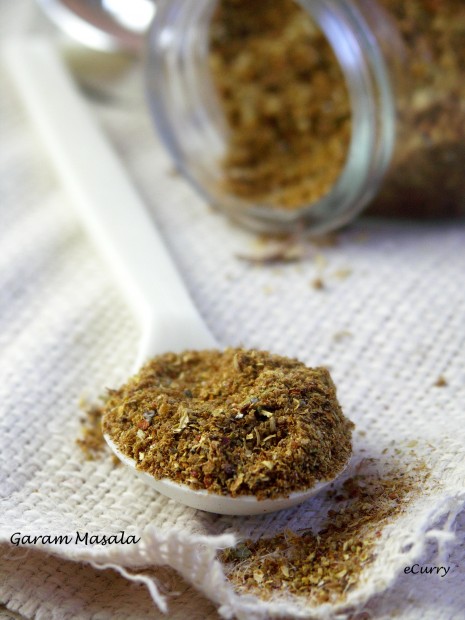
Now in Huffington Post!
Garam Masala is referred to a combination of different spices. It also refers to what the entire world calls the “curry powder“.
Garam = Hot/Heat; Masala= Spice Mix. The spices in India are usually used whole or ground into to a powder. If its used whole, they are usually added in the beginning of the recipe as way to temper a dish, and if used in the powder form, it is generally sprinkled on the dish after it is almost done cooking.
The term “curry powder” is non existent in an Indian kitchen. There are several spices used in every day cooking and they are combined in hundreds of ways in different parts of the country. There is no one curry powder. What is sold in the stores as “curry powder” is usually a combination of different spices blended together. Knowing that, the Garam Masala can be referred to as a kind of curry powder. As you can imagine, different combination of spice blends will make spiced powders/curry powders of different flavors and aroma.
This recipe is based on one that I had got from my friend’s mom. (Thanks Anuja! If you ever read this, you will know that I have not forgotten and will never forgot that wonderful aroma from your lunch box!) They belong to the state of Punjab. I had never asked the exact proportions of the spices, except the coriander has to twice the amount of the cumin, and of course the specific kind of spices that are used. Different regions in India, and also different households have their won way to make the Garam Masala. The Punjabi Garam Masala is typically not dry roasted and the Black Cardamom loses the sweet aroma on dry roasting it, but then again it is a personal choice.
Garam Masala is used to enhance the flavor in a dish and is used in very little quantity. I usually use about only 1/2 tablespoon of garam masala in a recipe for a serving of 4-5.
The hot/heat in Garam Masala is not the same kind of hot as in hot green peppers. It actually are the kind of spices that is used here which raises the body temperature. It is intense, warm, aromatic, lively and evocative.
The following is the recipe for Punjabi Garam Masala – the combination of spices being used in the northern regions of India. For this particular recipe, I do not roast the spices.
Lightly roasting the spices before grinding is another option and the spice mix is a little differently fragrant than this one here. If you are roasting the spices, do them in a dry thick bottomed skillet. Roast each spice individually until just fragrant. Cool before grinding. Do not roast the black cardamom.
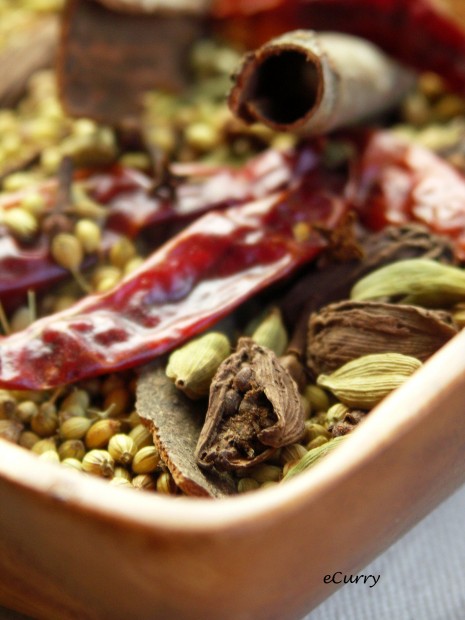
Garam Masala
Ingredients:
- 1/2 cup whole coriander seeds
- 1/4 cup cumin seeds
- 2 tablespoons small green cardamoms
- 6-8 black cardamoms
- 2 tablespoons cloves
- 1 tablespoon peppercorns
- 4 sticks of cinnamon, approx. 2″ each
- 3 bay leaves (Indian Tej patta)
- 3 red dry chili pepper
- 1/2 teaspoon of nutmeg
Note: For a roasted version, which has different flavors, dry roast whole spices separately until just fragrant.
Preparation:If you are roasting the spices, do them in a dry thick bottomed skillet. Roast each spice individually until just fragrant. They do burn very quick; watch them while roasting and take them off the heat the moment they get fragrant. Cool before grinding.
Grind all ingredients dry in a spice or coffee grinder.
May be stored in air tight containers for many months.
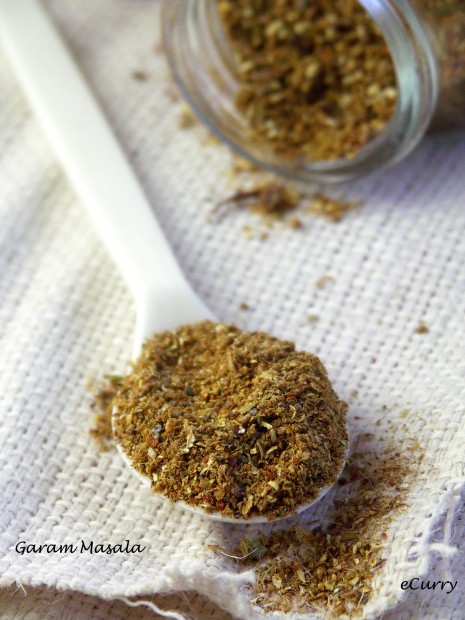

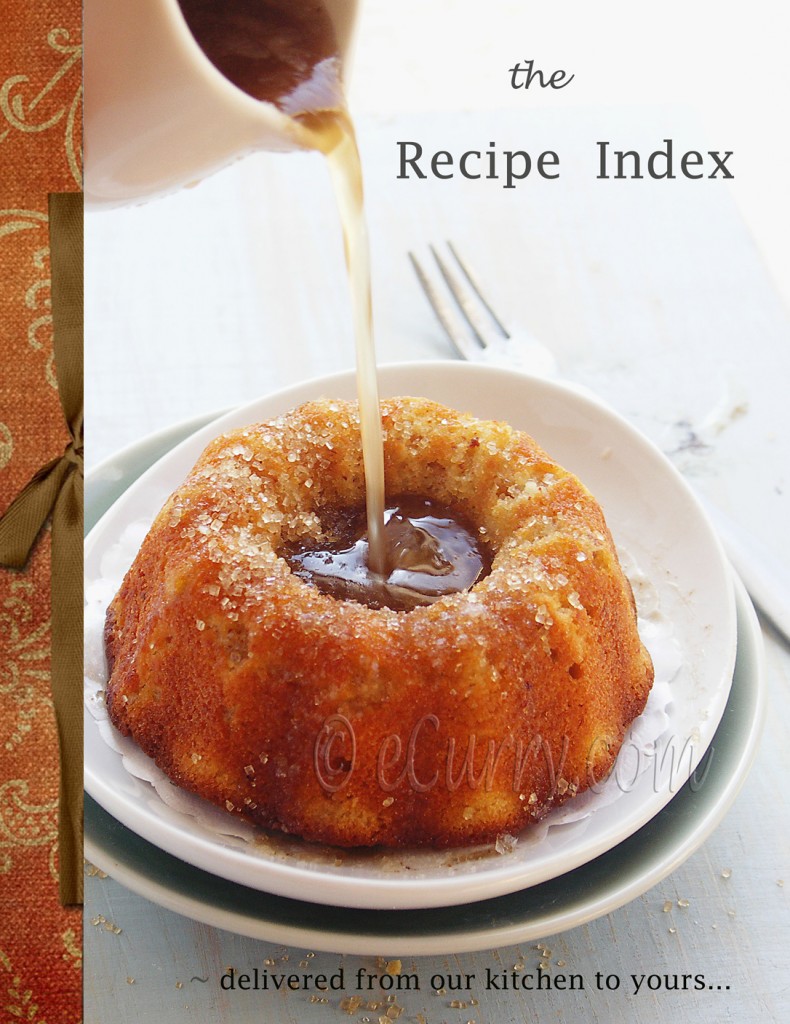
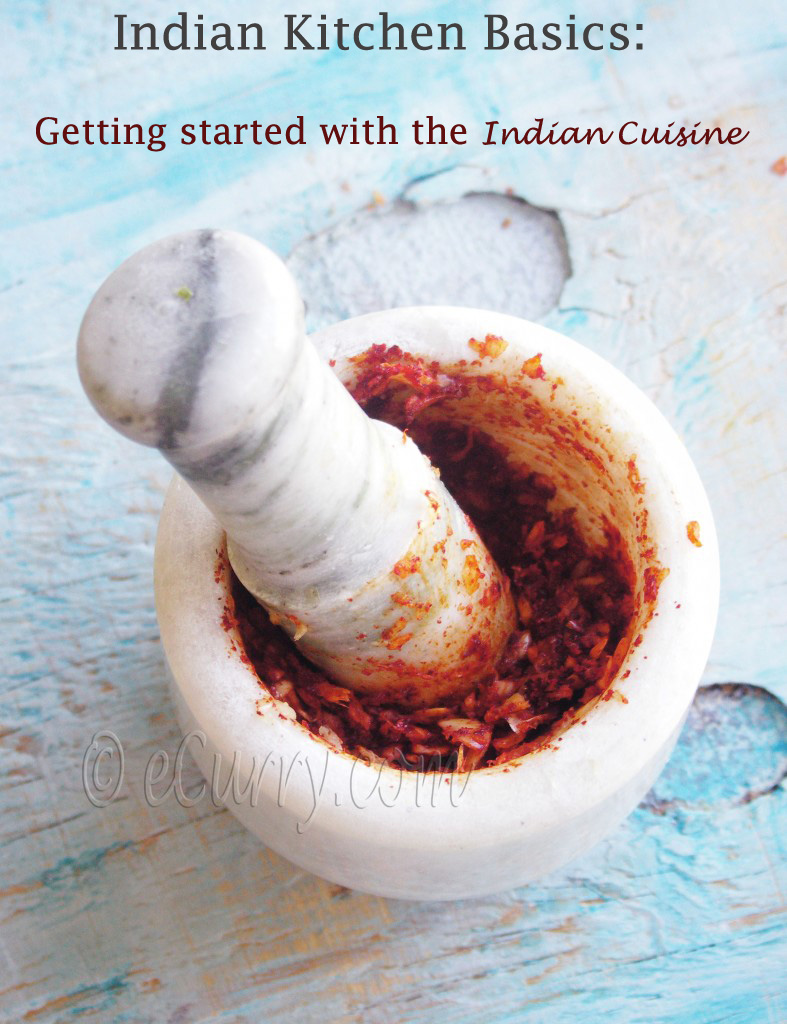
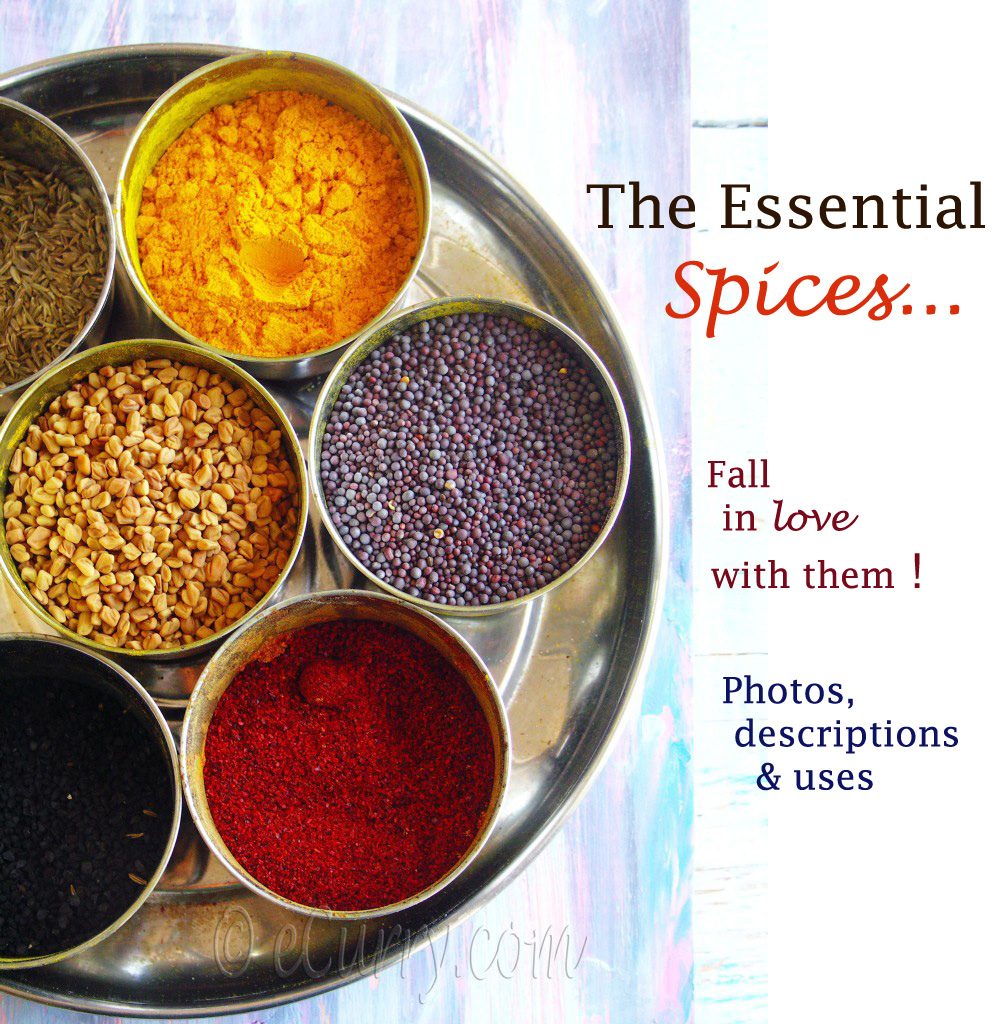








I’ve never used chillies in my garam masala, and also I toast my spices before grinding. I have some pictures on my blog if you are interested: http://mangosoup.blogspot.com/2009/08/making-spice-masalas-garam-masala.html
Nice recipe. I would firmly advise cooks to toast spices until fragrant before grinding, as there are volatile compounds in whole spices that are only unlocked by toasting the seed whole.
Also, don’t make a huge batch like this recipe suggests and store it for months. Make exactly as much as you need for your meal. If you want a flavor akin to the local Indian restaurant, toast and grind spices fresh for each meal, don’t use only a 1/3 teaspoon for 4 people, and fry your ground spices in plenty of ghee (clarified butter) for a minute or two before adding anything else to the pan.
Roasting spices is a personal choice. The two kinds will have two different flavors. Garam Masala stays fresh in air tight containers for at least 6 months, if not more.
All recipes in Indian cuisine (or restaurants) do not use garam masala. The flavor in Indian food is derived from different combination of spices and herbs, not just garam masala. If garam masala would be added to all recipes, they all would have the same flavor:-)
Whole spices are cooked in ghee before cooking, while garam masala is used during cooking. It is not usually fried in oil/ghee. If it is at all fried on certain circumstances, it is done briefly at low heat – frying them for a couple of minutes would burn them and make them bitter.
Thank you for opening my eyes and flovour buds. Having never tasted Garam Masala before we were very impressed with the new flavours it gave to our curry. We now want to make my own Garam Masala instead of the stuff that comes in the jar and the question for you is; Do we use the total pod of the Cardomom or just the seeds.
Thank you for a wonderful site. We found it by accident when looking for a recipe for Paratha and since then we are enjoying a world of flavours we never knew existed.
Henry
Thank you so much for you kind words:) You can use the entire pod of cardamom. Or take out the seeds. does not really matter, since you are going to grind everything into a powder. Good luck and hope you like the home made one. After the first time you can adjust the amount of each spice to suit your taste or have a different flavor every time!
[…] masala This recipe comes from ecurry. I recommend it. Use it in traditional Indian recipes or make up your own, as I did last week, […]
[…] Purtroppo non avevo il garam masala, ma sul sito di cui vi parlavo c’era la ricetta per farlo, e ho pensato di semplificare (si fa per dire) aggiungendo gli ingredienti che avevo in dispensa elencati nella sua lista. […]
[…] (the ready-made products which just sells as ‘curry powder’ are actually different versions of Garam Masala ). Curries differ in their taste and content, not just between countries but also within countries. […]
I am new to cooking curries and noticed that the smell and flavour you get from and Indian restaraunt differs greatly from the one you cook at home using curry powder,has the garam masala have anything to do with that.Also I would like to get some good recipes for curries if someone could help.
Thanks John.
Hi John,
Few things to know 🙂 and I know it is might seem complicated if you are just starting off. A lot of food that the Indian restaurants serve are kind of fancy (not all of them!!) and are not something we cook and eat at home everyday. I have made it the purpose of this blog to feature the recipes that we eat at home, our treasured ones. But I also have recipes here that are cooked in the restaurant for example the Murgh Makhani (Butter Chicken), Paneer Makhani – Butter Paneer, Murgh Tikka, Biryani, Palak Paneer/Saag Paneer: Spinach with Indian Cheese (and many more… if you are really interested browse through it. There is a Recipe Index on the top bar of the page; click on it and click where it says Indian. I have tried to categorize the recipes, but appetizers, dips etc which have Indian flavors might not all be there in that particular category). In the recipe posts which feature the recipes which are served in the Indian restaurants or the more popular ones, I have mentioned in the post about how it is cooked in restaurants…
There are so many reasons that the food cooked at home differs from rest. First of course is the difference in the professional cook. Being an Indian and growing up eating Indian food in India and also in restaurants, I find most Indian food in Indian restuarants in not authentic… a lot of the recipes are streamlined to suit the American taste (I am assuming you are writing from USA). So for us Indians, a lot of restaurants here do not match up to the expectation of traditional food in India.
The diffference in not becoz of the curry powder. The term “Curry Powder” is non existent in Indian vocabulary. There are just too many spices and mixes to call one as a curry powder. If you go to an Indian grocery check out the rows of spices and mix of spices and different brands. There are mixes available for particular dishes too, like Biryani Masala, Tandoori Masala etc. In all recipes here, I have mostly made the mixes at home, but I always mention the kind you get also get from the store, if you do not want to make your own.
While garam masala is one kind of a spice mix and the kind that is usually sold in stores as curry powder (again garam masala recipe differs from one home/and region to another in India), garam masala is not used in all recipes. Some curries might have almost no spice and yet it is a curry… so it is not the garam masala/curry powder which makes a curry. It is a process of cooking.
Again at home, we try to make food more healthy and which is not so in the restaurants. However I have a lot of recipes here which if you cook will match up to the tastes of the restaurants. It is not me saying it, see the comments in the Murgh Makhani (Butter Chicken).
I have a page on Curry (See the top bar).. and if you read through it, you would know what I am trying to say here.
I have also made pages to introduce the spices/spice mixes and some basic ingredients and techniques (Indian Kitchen Basics) – http://www.ecurry.com/blog/category/indian-kitchen-basics/ .. the list is growing to help one out, esp. for those starting off.
Not sure if I answered your questions. But if you need help, or if you would have more questions, do not hesiate to write !! I will answer them!
regards
Soma
Hi Soma thank you for your reply I live in Australia and like a lot of Australians we love Indian food. I will try your recipes and let you know how I go, again thank you for your help.
John.
Thanks! Hope you to try some!
[…] teaspoon of Garam Masala (also available in Indian […]
[…] came across a second comment about the order of Indian cooking. Indian spices are used whole or ground to a power. If you are […]
HELLO IM A NEW STUDENT IN HRM
Hi,
Thanx for the lovely recipe of garam masala, but could you tell more how restaurants have different aroma’s in their currys??
Thanx
Thanks for the garam masala…. Masala Ingredients
[…] you are already experienced in Indian cooking, just use the garam masala you use for Indian food. Here is a recipe for homemade garam masala I found, if you are interested in making it yourself. If you […]
[…] debris, measure and make a powder. Today’s punjabi garam masala powder recipe is from Soma’s blog which I made to try her murgh makhani. I made very little changes to the recipe and did not use red […]
[…] done, add the garam masala, stir it in and cover till ready to serve. The curry may be re heated in the pot or transferred to […]
Thanks for the recipe! I’ve been looking for a Punjabi version of garam masala.
Just to clarify, do you recommend to use bay leaves and not tej patta? I have both available.
Also, any dried chili peppers in particular? I know that many varieties are used in India.
Thanks from Columbus, Ohio!
I did mean Tej Patta and I have updated the post. Thanks for pointing that out. Use Tej Patta. Kashmiri Red Chilies or Deghi Mirch is good. But you can use any.
[…] sticks, methi/fenugreek seeds, tomato puree, red chili powder/cayenne pepper/paprika, almonds, garam masala, kasuri methi/dried fenugreek leaves, sugar or honey, and heavy cream. It had a curry taste to it […]
Couple of comments. Firstly, I disagree with the statement that garam masala is universally kown as “curry powder.” Almost every spice blend sold the world over as “curry powder” contains fairly hefty amounts of turmeric, and usually gets some of it’s flavour and fragrance from fenugreek. Neither of these spices are ever found in garam masala. If you have to identify what “curry powder” is closest to, it is surely going to be Madras masala. Of course there are many many different formulas for every spice blend in India, but I think my generalizations hold true.
Secondly, there is a mistranslation in the article, where it says garam masala means hot spices. Garam translates best into English as “warm or warming” not hot. Garam masala is not a spice blend known for being feiry. This is why detailed recipes will call for dried Kashmiri red chilies, which are very mild. The word garam is referring to what we in the West would call baking spices: cinnamon, clove, cardamom, nutmeg, mace. These are thought of as warming spices in India. Heaven knows, there is enough other hot stuff around if you want to sprinkle it on…
I’ve made this particular formula several times and it is delicious.
Thank you so very much for sharing your recipes and your experience with us – I am thrilled at having found your blog and plan on using it often! I came across your site while I was looking for a good basic recipe for Garam Masala and I really appreciated the variations that you mentioned and the manner in which you teach as you explain.
I am also very impressed by your kindness and good spirit. It is encouraging, especially in this day and age, to see someone leave aside their main interest and include a request for prayers for the countries and citizens who are suffering. And, I am touched by your dedication to the eBook where the profit is contributed to help with world hunger.
I’m a gray haired granny and I do believe that Love is one of the most essential ingredients for good food – you don’t hide your love and I am grateful to be able to use your recipes from a caring person.
Have a wonderful week and be blessed.
if we use garam masala instead of red chilli powder for cooking,is it good for health.